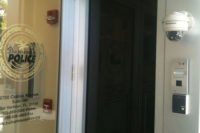
What is considered ‘perimeter’ access control these days? Is it the outer doors of a facility? The gate to the parking lot? Or even a venue off company grounds entirely?
“The definition of what a perimeter is has changed,” says Carlos Lopez-Reyna, product marketing manager, Honeywell, Louisville, Ky. “It used to be the area surrounding a building. Now it can include non-traditional perimeters such as an open space where a meeting is taking place. As a consequence, the behavior and mechanisms to protect and guard those spaces has changed.”
Though most facilities still define perimeter more locally, the way they are protecting it is changing and growing to include more of the latest high-tech products available to the access control world.
“If you look at the perimeter of the building versus the perimeter of the grounds, it is still somewhat market dependent,” says Jennifer Toscano, marketing manager, Schlage, Ingersoll Rand Security Technologies, Carmel, Ind. “An airport obviously thinks about perimeter fencing as part of its overall plan. Other environments tend to view them as separate. But we are beginning to see them converge. Historically they have involved different decision making at different points in time. But we are seeing more control now at more points and in some cases facilities are trying to direct traffic through specific entry points so they can be more easily monitored and controlled.”
Dave Adams, senior product marketing manager for physical access control, HID Global, Irvine, Calif., agrees. “My experience in the past is that perimeter and inside access control have been separate entities. What is the bare minimum to protect the perimeter of the building, not necessarily the property? The perimeter of the building is where all the capital has been and I would say going deeper within the building has had a higher priority than controlling the exterior of the property itself. But this can change overnight if something happens in that parking lot.”
Of course, government facilities and other critical infrastructure such as airports have been concerned about their outer perimeters for a while now. What is new is that corporate and other end users are starting to become more aware of the need for higher security there.
“I think in some cases facilities are starting to be more diligent about having access control at the perimeter,” Toscano says. “Today it tends to be more high security, government applications. But schools and hospitals and small office buildings are starting to secure the perimeters more than they did 10 years ago. The perimeter is moving outward.”
Beth Thomas, senior product marketing manager, Honeywell, says that increased threats have been a factor in driving certain markets to look to their perimeters. “Organizations are starting to look at security not just at the building level but at the campus level or parking level. Threats at the parking lots threaten the population of the facility.”
Richard Sedivy, director of marketing, Doorking, Inglewood, Calif., adds, “A lot of businesses are realizing that they need to better protect their employees and part of that is knowing who is on your premises and who is not.”
INCORPORATING NEW TECHNOLOGY
A primary reason for the upsurge in perimeter access interest is recent technologies that have entered the access control market and are making difficult perimeter applications not only possible, but desirable.
“Perimeter access control used to be ‘let’s trench everything and run wires all over the place,’” says Bret Tobey, intelligent openings business development and product manager, Assa Abloy Americas, New Haven, Conn. “Now we are seeing people use either their network infrastructure, Wi-Fi or point-to-point protocol. The days of trenching are pretty much over unless the customer wants that. We see guys with directional antennas throwing Wi-Fi several kilometers. End users are more willing to put perimeter access control in places they weren’t considering it before, like gates and fences.”
Now there are myriad ways to get power far from the building without trenching — including wireless, solar, cellular and UHF signals.
“Typically what we find is a lot of this is coming in after market and a facility has an access control system that they want to broaden out to the perimeter,” says Mark McBroom, product manager, Securitron, Sparks, Nev. “The system is capable of handling the extra gate, but how do we get power out to it? We work with cellular access control and solar. There are various ways of going wireless out to a gate and providing some kind of power out there where you are not having to trench.”
Toscano adds, “There are a couple of things we offer for wireless access solutions. We are seeing an increased popularity of those for perimeter applications. Indoor applications typically go 200-300 feet but outdoors can go up to 4,000 feet with a signal boost. It really helps with entry points like fences and gates without having to trench the parking lot.”
Wireless technology is available in many forms. Some are here now and others are exciting developments that may become standard in years to come.
“I see a trend towards starting to use UHF technology, which in the past we haven’t really done because it was an unsecure technology,” Adams says. “The exciting thing about it is that with new chips that are coming out we now have the ability to add security and protect the identity of the chip.
“We have been using active UHF, like key fobs for the car, for quite some time, but the problem is batteries wear out. Passive UHF is no more expensive than a typical smart card and we can create multi-tech cards to include UHF, high frequency iCLASS and quite possibly a third prox antenna.”
Another potential wireless option is the use of cellular phones or even the Bluetooth technology within them.
“Every phone made now has a Bluetooth radio in it,” Adams says. “It can be used at great distances and you can authenticate who is going through a door or gate using the identity placed on the phone as well as a PIN code through the phone.”
Wireless has gained in popularity not only because of the convenience but also reliability.
“People are more comfortable with wireless solutions than two years ago,” Thomas says. “I think the general attitude in the market has changed.”
Another high-tech solution being implemented in the perimeter access market is biometrics.
“Before, parking was pretty much a ticket with a bar code or stamp on it,” says Alex Franco, regional sales director, export, Amano Cincinnati, Palm Harbor, Fla. “Now people are using biometrics like fingerprint or palm of hand, retina or facial recognition for more security when entering those parking lots.”
Thomas comments, “We have seen cases where just having simple card access does not suffice because it is easy to lose a card. Extra factors of authentication become important. Many places are using PIN codes, but for critical infrastructures there is a trend or drive to biometrics.”
In the future there may be even more of a marriage between long range technology and biometrics, Adams adds. “We are looking at some alternate technology for long-range where we would actually be using a camera to identify people as well as their credential at fairly moderate distances of up to seven feet. Other companies are looking at doing iris recognition and even facial recognition at a distance.”
Sophisticated technology doesn’t come without drawbacks, however. A lot of these systems, when used in an indoor, controlled environment are just fine, but perimeter locations pose more of a challenge.
“One of the pieces of equipment we sell for such things is a temperature controlled enclosure,” says Scott Hullinger, vice president of Mier Products, Kokomo, Ind. “Lots of systems now use fiber optics which can get brittle in cold conditions.
“We also provide a non-metallic enclosure because so much equipment is going wireless. Instead of using a traditional metal enclosure with an antenna on the outside they want to be able to put the entire unit on the inside.”
Both for weather and vandalism protection, enclosures can be a necessary step to protect equipment in more remote locations, Hullinger adds.
WHAT END USERS WANT
Customers not only want perimeter systems that are more high tech and easy to use, they want them to be fully featured and functional as well.
“People aren’t relying on just one particular type of system anymore,” Hullinger says. “They are using a combination of cameras, metal detection and other types of surveillance. Instead of using one company’s system now there may be five different companies involved at each gate.”
Franco agrees. “Times have changed. There is more of a need for full authentication and knowing that an individual is truly the owner of the vehicle. They want systems that are integrated. They want parking equipment, barrier gates integrated with access control and CCTV.”
Changing attitudes are affecting the way perimeter security is thought of and planned for.
“There is more convergence where perimeter controls are integrated into a security system that can tie CCTV and access control for monitoring,” Toscano adds. “I do believe those things are being tied together more and more. Historically, parking was parking before. Gate access was exactly that. But that viewpoint has evolved to being part of the overall security plan.”
In addition, more facilities are becoming aware of the need to track people and vehicles starting at the gate.
“What it really boils down to is they want more information from more openings, Tobey says. “Traditionally big access control systems might control five percent of doors. Now they are looking at outside doors that they had decided not to secure before and realizing that they can get more information from more openings easier than they could in the past.”
INTEGRATOR BENEFITS
What this means for the dealer or integrator is increased business opportunities, particularly with existing customers.
“It will mean more business for dealers and installers, hopefully,” Sedivy says. “Companies might want to upgrade their access system to include some of this newer technology coming out.”
Toscano believes these opportunities could provide respite in a deteriorating new construction market and revisit projects previously not viable. “I think it will enable integrators to go back to an account that they couldn’t provide perimeter protection for initially and provide a wireless solution. With new construction being slow, integrators are looking for opportunities to grow existing applications and add to aftermarket sales.”
But dealers need to ask the right questions, Thomas adds. “People are starting to pay a lot more attention to perimeters domestically. Dealers and integrators need to inquire about a facility’s perimeter, which is a question they may not be asking right now.”
Taking technology to the outer edge could be a real benefit for dealers, Tobey says. “Folks who are savvy and aware of this will find more opportunities because there is more work after the fact for configuration and getting systems to talk to each other. As tech bundles become less expensive on the hardware side, we will see a whole new wave where there are probably 10 times as many openings not served by access control, that they can go back to their installed base and get another wave of revenue out of them.”
Example Applications
Examples of successful perimeter applications range from high-end government to manufacturing and sports arenas.
“ We have a high-end parking system installed at a new stadium,” says Alex Franco at Amano Cincinnati. “It starts from the standard hardware including barrier gates, ticket dispensers, pay stations and fully automated software. Everything is managed on their network and it is a full parking software management system.”
“ Our bioCLASS line is used in South African mines to gain access to perimeters of sites using fingerprint technology,” says Dave Adams, at HID Global.
“ We have some cellular sites in a Western beverage facility,” says Mark McBroom at Securitron. “They have several offsite areas where they had storage units but were unable to run cabling out there so they were really big on using cellular access along with solar panels. The biggest thing for them was accountability. They wanted to know who went through those gates and when.”
“ A big one for us is on a military base,” says Scott Hullinger at Mier Products. “They were using several different systems including gate systems, cameras and card access,” and they wanted to put all those other companies’ systems in our enclosure to be both tamper and weather proof. They wanted to know beyond a shadow of a doubt that someone is at that gate. But the equipment used to do that is a lot more technologically advanced and needs that temperature and weather controlled environment.”
“ A large pharmaceutical plant on the East Coast was really concerned about people getting into their facility,” says Beth Thomas at Honeywell. “These types of facilities have a campus environment with several buildings and they struggled with how to keep intellectual property safe.”
The town of Estes Park, Colo., uses wireless locks on perimeter doors to improve security, monitoring and key control, relates Jennifer Toscano at Schlage, Ingersoll Rand.








